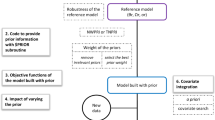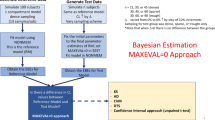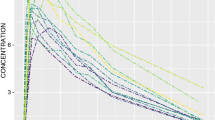Abstract
Background and objectives
This study examined parametric and nonparametric population modelling methods in three different analyses. The first analysis was of a real, although small, clinical dataset from 17 patients receiving intramuscular amikacin. The second analysis was of a Monte Carlo simulation study in which the populations ranged from 25 to 800 subjects, the model parameter distributions were Gaussian and all the simulated parameter values of the subjects were exactly known prior to the analysis. The third analysis was again of a Monte Carlo study in which the exactly known population sample consisted of a unimodal Gaussian distribution for the apparent volume of distribution (Vd), but a bimodal distribution for the elimination rate constant (ke), simulating rapid and slow eliminators of a drug.
Methods
For the clinical dataset, the parametric iterative two-stage Bayesian (IT2B) approach, with the first-order conditional estimation (FOCE) approximation calculation of the conditional likelihoods, was used together with the nonparametric expectation-maximisation (NPEM) and nonparametric adaptive grid (NPAG) approaches, both of which use exact computations of the likelihood.
For the first Monte Carlo simulation study, these programs were also used. A one-compartment model with unimodal Gaussian parameters Vd and ke was employed, with a simulated intravenous bolus dose and two simulated serum concentrations per subject. In addition, a newer parametric expectation-maximisation (PEM) program with a Faure low discrepancy computation of the conditional likelihoods, as well as nonlinear mixed-effects modelling software (NONMEM), both the first-order (FO) and the FOCE versions, were used.
For the second Monte Carlo study, a one-compartment model with an intravenous bolus dose was again used, with five simulated serum samples obtained from early to late after dosing. A unimodal distribution for Vd and a bimodal distribution for ke were chosen to simulate two subpopulations of ‘fast’ and ‘slow’ metabolisers of a drug. NPEM results were compared with that of a unimodal parametric joint density having the true population parameter means and covariance.
Results
For the clinical dataset, the interindividual parameter percent coefficients of variation (CV%) were smallest with IT2B, suggesting less diversity in the population parameter distributions. However, the exact likelihood of the results was also smaller with IT2B, and was 14 logs greater with NPEM and NPAG, both of which found a greater and more likely diversity in the population studied.
For the first Monte Carlo dataset, NPAG and PEM, both using accurate likelihood computations, showed statistical consistency. Consistency means that the more subjects studied, the closer the estimated parameter values approach the true values. NONMEM FOCE and NONMEM FO, as well as the IT2B FOCE methods, do not have this guarantee. Results obtained by IT2B FOCE, for example, often strayed visibly away from the true values as more subjects were studied.
Furthermore, with respect to statistical efficiency (precision of parameter estimates), NPAG and PEM had good efficiency and precise parameter estimates, while precision suffered with NONMEM FOCE and IT2B FOCE, and severely so with NONMEM FO.
For the second Monte Carlo dataset, NPEM closely approximated the true bimodal population joint density, while an exact parametric representation of an assumed joint unimodal density having the true population means, standard deviations and correlation gave a totally different picture.
Conclusions
The smaller population interindividual CV% estimates with IT2B on the clinical dataset are probably the result of assuming Gaussian parameter distributions and/or of using the FOCE approximation. NPEM and NPAG, having no constraints on the shape of the population parameter distributions, and which compute the likelihood exactly and estimate parameter values with greater precision, detected the more likely greater diversity in the parameter values in the population studied.
In the first Monte Carlo study, NPAG and PEM had more precise parameter estimates than either IT2B FOCE or NONMEM FOCE, as well as much more precise estimates than NONMEM FO. In the second Monte Carlo study, NPEM easily detected the bimodal parameter distribution at this initial step without requiring any further information.
Population modelling methods using exact or accurate computations have more precise parameter estimation, better stochastic convergence properties and are, very importantly, statistically consistent. Nonparametric methods are better than parametric methods at analysing populations having unanticipated non-Gaussian or multimodal parameter distributions.














Similar content being viewed by others
Notes
This software is available from the corresponding author by license from the University of Southern California for a nominal donation.
References
Schumitzky A. The nonparametric maximum likelihood approach to pharmacokinetic population analysis. Proceedings of the 1993 Western Simulation Multiconference: Simulation for Health Care; 1993 Jan 17–19; La Jolla (CA): San Diego (CA): Society for Computer Simulation, 1993: 95–100. (Also available as Technical Report 92–3. Los Angeles [CA]: Laboratory of Applied Pharmacokinetics, USC School of Medicine, 1992)
Schumitzky A. Nonparametric EM algorithms for estimating prior distributions. Appl Math Comput 1991; 45: 143–57
Schumitzky A. EM algorithms and two stage methods in pharmacokinetic population analysis. In: D’Argenio DZ, editor. Advanced methods of pharmacokinetic and pharmacodynamic systems analysis II. New York: Plenum Press, 1995: 145–60
Leary R, Jelliffe R, Schumitzky A, et al. A unified parametric/nonparametric approach to population PK/PD modeling. Annual Meeting of the Population Approach Group in Europe; 2002 Jun 6–7; Paris
Beal S, Sheiner L. NONMEM user’s guide I: users basic guide. San Francisco (CA): Division of Clinical Pharmacology, University of California, 1979
Sheiner L. The population approach to pharmacokinetic data analysis: rationale and standard data analysis methods. Drug Metab Rev 1984; 15: 153–71
Beal S. Population pharmacokinetic data and parameter estimation based on their first two statistical moments. Drug Metab Rev 1984; 15: 173–93
Rowland M, Sheiner L, Steimer JL, editors. Variability in drug therapy: description, estimation, and control. New York: Raven Press, 1985
Davidian M, Giltinan D. Nonlinear models for repeated measurement data. New York: Chapman and Hall, 1995
Jelliffe R, Schumitzky A, Van Guilder M, et al. User manual for version 10.7 of the USC*PACK Collection of PC Programs, USC Laboratory of Applied Pharmacokinetics. Los Angeles (CA): USC School of Medicine, 1995 Dec 1
Sheiner L, Beal S, Rosenberg B, et al. Forecasting individual pharmacokinetics. Clin Pharmacol Ther 1979; 26: 294–305
Jelliffe R. Explicit determination of laboratory assay error patterns: a useful aid in therapeutic drug monitoring (no. DM 89–4 [DM56]). Drug Monit Toxicol 1989; 10 (4)
Jelliffe R, Schumitzky A, Van Guilder M, et al. Individualizing drug dosage regimens: roles of population pharmacokinetic and dynamic models, bayesian fitting, and adaptive control. Ther Drug Monit 1993; 15: 380–93
De Groot M. Probability and statistics. 2nd ed. (reprinted 1989). Reading (MA): Addison-Wesley, 1986: 420–3
Lindsay B. The geometry of mixture likelihoods: a general theory. Ann Stat 1983; 11: 86–94
Mallet A. A maximum likelihood estimation method for random coefficient regression models. Biometrika 1986; 73: 645–56
Maire P, Barbaut X, Girard P, et al. Preliminary results of three methods for population pharmacokinetic analysis (NONMEM, NPML, NPEM) of amikacin in geriatric and general medicine patients. Int J Biomed Comput 1994; 36: 139–41
Spieler G, Schumitzky A. Asymptotic properties of extended least squares estimates with application to population pharmacokinetics. Proceedings of the American Statistical Association, Biopharmaceutical Section. 1993 Aug 8–12; San Francisco (CA). Alexandria (VA): American Statistical Association, 1993: 177–82. (Also available as Technical Report 92–4. Los Angeles [CA]: Laboratory of Applied Pharmacokinetics, USC School of Medicine, 1992)
Vonesh E, Chinchilli V. Linear and nonlinear models for analysis of repeated measurements. New York: Marcel Dekker, 1997
Leary R, Jelliffe R, Schumitzky A, et al. Improved computational methods for statistically consistent and efficient PK/PD population analysis [poster]. Annual Meeting of the Population Approach Group in Europe; 2003 Jun 12–13; Verona
Bennet JE, Racine-Poon A, Wakefield JC. Markov chain Monte Carlo for nonlinear hierarchical models. In: Gilks WR, Richardson S, Spiegelhalter DJ, editors. Markov chain Monte Carlo in practice. London: Chapman and Hall, 1996: 339–57
Bertilsson L. Geographic/interracial differences in polymorphic drug oxidation. Clin Pharmacokinet 1995; 29: 192–209
Bustad A, Jelliffe R, Terziivanov D. A comparison of parametric and nonparametric methods of population pharmacokinetic modeling [poster]. Annual Meeting of the American Society for Clinical Pharmacology and Therapeutics; 2002 Mar 26; Atlanta (GA)
Jelliffe R. Estimation of creatinine clearance in patients with unstable renal function, without a urine specimen. Am J Nephrol 2002; 22: 320–4
Beal L, Sheiner L, editors. NONMEM version V.1.1 users guides. San Francisco (CA): University of California, 1999
Girard P, Mentre F. A comparison of estimation methods in nonlinear mixed effects models using a blind analysis [online]. 14th meeting of the Population Approach Group in Europe; 2005 Jun 16–17; Pamplona. Available from URL: http://www.page-meeting.org/default.asp?.id=26&keuze=meeting [Accessed 2006 Jan 20]
Terziivanov D, Bozhinova K, Dimitrova V, et al. Nonparametric expectation maximisation (NPEM) population analysis of caffeine disposition from sparse data in adult Caucasians: systemic caffeine clearance as a biomarker for cytochrome P4501A2 activity. Clin Pharmacokinet 2003; 42: 1393–409
Bertsekas D. Dynamic programming: deterministic and stochastic models. Suboptimal and adaptive control: section 4.1: certainty equivalent control. Englewood Cliffs (NJ): Prentice-Hall, 1987: 144–6
Taright N, Mentre F, Mallet A, et al. Nonparametric estimation of population characteristics of the kinetics of lithium from observational and experimental data: individualization of chronic dosing regimen using a new bayesian approach. Ther Drug Monit 1994; 16: 258–69
Bayard D, Jelliffe R, Schumitzky A, et al. Precision drug dosage regimens using multiple model adaptive control: theory and application to simulated vancomycin therapy. In: Sridhar R, Rao K, Lakshminarayanan V, editors. Selected topics in mathematical physics. Professor R. Vasudevan memorial volume. Madras: Allied Publishers Inc., 1995: 407–26
Jerling M. Population kinetics of antidepressant and neuroleptic drugs: studies of therapeutic drug monitoring data to evaluate kinetic variability, drug interactions, nonlinear kinetics, and the influence of genetic factors [PhD thesis]. Stockholm: Division of Clinical Pharmacology, Department of Medical Laboratory Sciences and Technology, Karolinska Institute at Huddinge University Hospital, 1995: 28–9
Jelliffe R, Schumitzky A, Bayard D, et al. Model-based, goal-oriented, individualised drug therapy: linkage of population modelling, new ‘multiple model’ dosage design, bayesian feedback and individualised target goals. Clin Pharmacokinet 1998; 34: 57–77
Bayard D, Milman M, Schumitzky A. Design of dosage regimens: a multiple model stochastic approach. Int J Biomed Comput 1994; 36: 103–15
Acknowledgements
The preparation of this manuscript was supported by US Government grants RR11526, GM65619 and GM068968.
Many thanks to Dr Irina Bondareva of the Institute for Physical-Chemical Medicine, Moscow, Russia, for her very thoughtful help and critiques in the preparation of this manuscript.
The authors have no financial conflicts of interest relevant to the contents of this study.
Author information
Authors and Affiliations
Corresponding author
Additional information
At the time of preparation of this manuscript Robert Leary was employed at the San Diego Supercomputer Center, San Diego, CA, USA.
Rights and permissions
About this article
Cite this article
Bustad, A., Terziivanov, D., Leary, R. et al. Parametric and Nonparametric Population Methods. Clin Pharmacokinet 45, 365–383 (2006). https://doi.org/10.2165/00003088-200645040-00003
Published:
Issue Date:
DOI: https://doi.org/10.2165/00003088-200645040-00003




